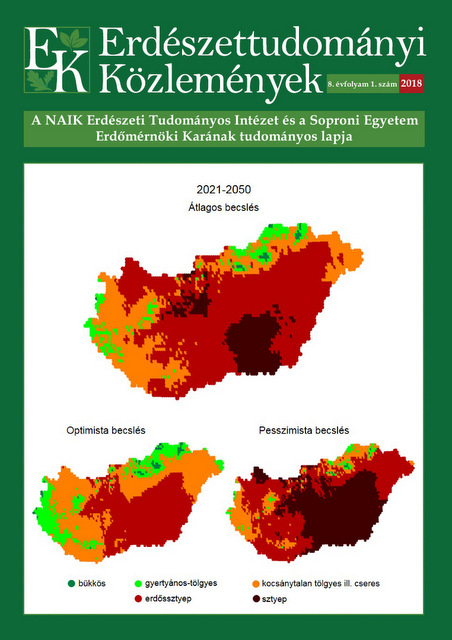Climate projections for forestry in Hungary
Borbála Gálos & Ernő Führer
Correspondence
Correspondence: Gálos Borbála
Postal address: H-9400 Sopron, Bajcsy-Zsilinszky u. 4.
e-mail: galos.borbala[at]uni-sopron.hu
Abstract
Tree species selection and decision support in forestry require long term climate projections. Our study is focusing on the future temperature and precipitation conditions for the months that are determining and limiting the distribution, vitality, growth and production of forests. For the 21st century, results of 12 regional climate model simulations were analyzed assuming the A1B emission scenario of the lPCC. Forest climate categories as well as the droughts were defined based on the forestry aridity index (FAI).
Increase of temperature and decrease of precipitation are expected to be the largest in the critical period (July-August), but they are also significant in the main growing period (May-August). In the Hungarian lowland the drier conditions (Forest steppe climate category) are expected to expand (replacing the former Oak climate category) and cover more than 35% of the total forest area. This will result also in novel combinations of site factors that have not existed in Hungary before. Based on the mean estimations, these so called ‘Steppe climate category’ can reach more than 10% of the country until the middle of the century. In absence of surplus water, these climate conditions will not be suitable for managed forests any more. Additionally to the changes of the climatic means, the total number of droughts and extremely droughts can be doubled for the period 2021-2050 relative to 1981-2010. Water scarcity and extremely high temperatures can enhance the drought risk thus can lead to severe impact on the vitality, growth and organic matter production of the trees.
Based on the expected climate conditions the Agroclimate Decision Support System defines the forestry climate category for the selected region and makes suggestion for the tree species composition.
Keywords: climate change, climate projection, forest climate categories, forestry aridity index, drought frequency
Open Acces
For non-commercial purposes, let others distribute and copy the article, and include in a collective work, as long as they cite the author(s) and the journal, and provided they do not alter or modify the article.
Cite this article as:
Gálos, B. & Führer, E. (2018): Climate projections for forestry in Hungary. Bulletin of Forestry Science, 8(1): 43-55. (in Hungarian) DOI: 10.17164/EK.2018.003
Volume 8, Issue 1
Pages: 43-55
First published:
28 May 2018
Related content
7
More articles
by this authors
6
Related content in the Bulletin of Forestry Science*
More articles by this authors in the Bulletin of Forestry Science
* Automatically generated recommendations based on the occurrence of keywords given by authors in the titles and abstracts of other articles. For more detailed search please use the manual search.
